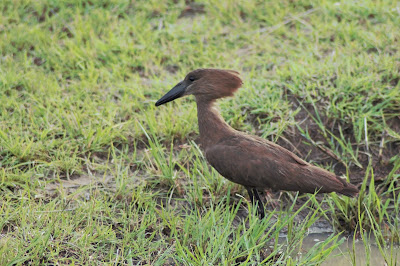The Mara comprises a very large grassland plain (1500 sq km)with small areas of trees particularly close to water sources. The area has been home to the nomadic Masai tribe for over 200 years and they still heard cattle and goats there to this day. The Mara stretches into the neighbouring Tanzania but the Masai can travel at will across the border in search of better grazing. During this trip we visited a small encampment and were shown around by a very aloof but friendly chief's son and I have to tell you that their homes are very basic indeed.
Anyhow more on that later, on with the photos.
A view across the Serengeti, at other times of the year this would be covered with Zebra, Wildebeest and other herbivores.
Hotel info with some geographical detail.
Not a great photo of a paradise Flycatcher, he landed outside the apartment but by the time I got the camera I only got one shot
Green Bee-Eater
Lilac Breasted Roller
A small family of Egyptian Geese, these are pretty common all over Kenya from what I can see.
Our guide was very keen to show us some Cheetah lounging by a bush so I almost missed this guy. Its a lifer for me the Black Bellied Bustard. We did spot another the following day but it was deep in a bush so I was glad I got this pic.
Not really giving any prizes for guessing the Common Ostritch (male).
I was surprised at how many Secretarybirds we spotted around the Mara.
These were once a nemesis bird for me, I seemed to miss them wherever I went in Saudi Arabia, but finally found a small flock of Hamerkop. This one and its partner were hunting by the roadside as we passed.
We were heading back after a long day and came across a couple of these Grey Crowned Crane. I had not seen one of these before and was surprised how big they are.
A silhouette of a pair of Sacred Ibis in the early morning.
White Wagtail
Distant shot of a Shrike but not sure which one.
A Pair of Yellow Billed Oxpecker perched on a Buffalo as we drove past.
A bit early in the morning for this shot but hopefully you can make out the jet black body with the bright red breast of the Scarlet Chested Sunbird.
A White Browed (Heuglin's) Robin Chattaking a wash in the stream beside our hotel.
The Common Bulbul were just that, pretty common all over the country. They were particularly vocal in the morning.
I only spotted this guy at the last minute so did not get a good photo, but anyway nice to see a Hyena
and not too far away was a Topi and youngster, This little one can't have been more than a week old as it was still a bit shaky on its feet.
There were a small number of Elephant wandering around in the Mara, I was surprised at how few there were.
A pair of young male Wildebeest sparring. This goes on quite a bit but is not serious at this time of the year. They are really just sizing each other up for the new years mating season.
A lone Wildebeest wandering across the plain. While the vast majority take part in the Great Migration a few do remain. Trouble is there are then a lot of carnivores and much fewer prey so I would guess life gets pretty precarious.
A small band of Lioness taking it easy on some rocks. It all looked pretty sedate but tey were constantly on the lookout for lunch.
A couple of Hartebeest and young grazing happily.
Spotted a few Cheetah around the Mara, unfortunately none were particularly active, there were two lounging about beside this bush.Love was in the air here, shortly after I took this these two mated. Apparently he will stay with her for a week or more until she is ready and then about 110 days later the little ones arrive.
A mother and young Thompson's Gazelle. There were not many of these about the place so little wonder that mum was very wary.
The Masai
We visited a small Masai village and they were ok with me taking some photos which are below. They tend to move village every few months or depending on the conditions. At the time of our visit there had been little or no rain for quite a while so everything was a bit dry.
We had such an amazing time on safari and I doubt I will ever forget the experience. I don't have names for all of the creatures I photographed above but thought perhaps someone online might know. If you do drop me a note. Anyway hope this inspires you to get out and visit these amazing places.

















































